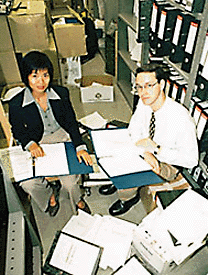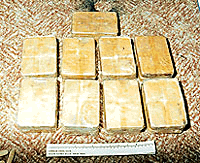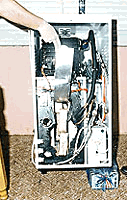



















|
NARCOTICS BUREAU TEAM TOPPLES A DRUG SYNDICATE
| ||
 Cheng and Snaith; "So we dug up a lot of circumstantial evidence and piled it together. In theend - that's how we got the conviction" Self-Styled drug kingpin and Pit Bull breeder who gambled on dog fights and drove luxury cars, Tang Tai-ming [not his real name], became the last High Court criminal to be convicted under British rule in Hong Kong when a jury returned guilty verdicts against him for conspiracy to smuggle drugs and money laundering on 27 June 97. Both his wife and sister were also convicted of laundering millions of dollars in local bank accounts. ¡@All three denied the charges stemming from a sophisticated criminal enterprise that involved smuggling large quantities of heroin from Hong Kong to Sydney packed inside specially manufactured water heating systems. The heroin was then sold on Sydney's local drug market and some of the proceeds remitted through Australian banks back to personal Hong Kong bank accounts. ¡@From July 1994 to October 1995, twelve batches of No. 4 grade heroin were flown from Hong Kong to Sydney inside the water heating units. The general manager of an international cargo company used by the smugglers gave evidence in the trial of Tang. ¡@For Hong Kong Police, the case began when enquiries into a drug syndicate revealed that they had been in close contact with international air cargo companies. Ng [not his real name], a close friend of Tang, had visited air cargo companies over the previous months. ¡@When Hong Kong Police learned that Ng had been using the company to ship large crates suspected to contain heroin to Sydney, they tipped off Australian police. In November 1995, after extensive surveillance, officers from the Australian National Crime Authority (NCA) raided the traffickers' house, arrested four persons and seized over 17 kilograms of heroin, drug manufacturing equipment, pieces of paper with bank account numbers of people in Hong Kong and other documents (one of which included Tang's name) linking the two parts of the syndicate together. Subsequent raids were carried out in Hong Kong, but Ng and three other syndicate members had already fled Hong Kong and are still on the run. Tang, his wife and sister, however, were arrested. ¡@Although Tang was now a prime suspect – police had no concrete evidence connecting him directly to the heroin. He claimed his swollen bank accounts were the result of dog breeding profits, gambling, designer watches, car and real estate deals. ¡@However, the exceptional investigative work of Hong Kong Detective Senior Inspector Stuart Snaith, DCIP Nelson Cheung Yiu-mo and Detective Woman Senior Inspector Carol Cheng Mei-lin of Financial Investigations (as tenacious as any of Tang's Pit Bulls), not only convinced a jury to convict him on conspiracy to smuggle drugs - it also helped to produce the second largest money laundering case in Hong Kong's history. These charges were brought under the drug trafficking (Recovery of Proceeds) ordinance. ¡@"In this case, in order to convict Tang on money laundering and drug charges, it was necessary to prove that the money coming from Australia to Hong Kong was the actual drug money from the traffickers in Australia," said Detective Senior Inspector Stuart Snaith. "Initially, the main problem was the lack of evidence connecting Tang directly to the heroin." ¡@"So we dug up a lot of circumstantial evidence and piled it together. In the end - that's how he was convicted," said WDSI Cheng. ¡@To reveal Tang's connection to the syndicate, the two detectives followed a paper trail that criss-crossed the Pacific between Sydney and Hong Kong and took well over a year. ¡@"By the end of the case, we had volumes of documents and binders - a tangled web of money transactions, bank and telephone records and immigration records," recalls DSI Snaith. ¡@Snaith and Cheng set out to link Tang to the drugs in a variety of ways. Analysis of bank accounts both in Australia and Hong Kong showed that the Australian traffickers had structurally remitted funds to 21 bank accounts in Hong Kong. The recipients of these funds from Australia included Tang himself as well as his younger sister. ¡@"In a one-and-a-half month period she received AUS$1.5 million telegraphically transferred to her account from Australia," recalls WDSI Cheng. "She would then write cheques to others, who would eventually give cash to Tang. From bank records we could see that Tang was the ultimate recipient of these moneys." | ||
| Detectives Snaith and
Cheng also produced banking documents showing how Ng,
who ran a transportation company, would keep himself one stage back from actually
receiving drug money by getting his employees (later used as court witnesses) to open
bank accounts for him but in their names. Drug money from Australia would be remitted
into those accounts then be withdrawn and given to Ng.
¡@To prove this was cash from the sale of drugs from the same group smuggling heroin into Sydney from Hong Kong, the Narcotics Bureau worked closely with their Australian counterparts who did a lot of surveillance work documenting the traffickers going from bank to bank with bags full of money making international transfers of between AUS$9,000 and AUS$40,000 using false driver licences to mask their identities. ¡@"In this investigation, through bank records we were able to show that the money received by Tang, Ng and Tang's sister in Hong Kong originated from the four traffickers arrested in Sydney. Also, much of the money Tang received was retained by him or spent on luxury goods. This indicated that Tang, together with Ng were the ultimate recipients of the money from Australia," said DSI Snaith. ¡@Over the course of the 18-month investigation, WDSI Cheng, accompanied with colleagues DCIP Nelson Cheng Yiu-mo, Sergeant Chan Kwok-hung and DPC So Ping-tim from Narcotics Bureau travelled to Australia several times to gather evidence and collect documentary exhibits. |
 Seized high-grade heroin smuggled into Sydney by Hong Kong syndicate
|
|
¡@Meanwhile, evidence of Tang's movements and contacts were being compiled. Earlier surveillance operations showed Tang attending meetings with Ng and other syndicate members a few days before shipments were made. Usually they would meet at a car repair garage operated by Ng and play mahjong late into the night. Other syndicate members would contact the air cargo companies to arrange for the water systems to be collected from the crating company. This evidence was put to the jury and they were asked to draw the inference that Tang attended these meetings to direct the whole operation. ¡@Tang was linked further to Ng and the other syndicate members through immigration records showing that they had travelled together to Macau and Taiwan. ¡@Both detectives Snaith and Cheng felt enormous satisfaction at the outcome of the case (Tang received 30 years for the trafficking charge and ten for money laundering, while his wife and sister both received seven years). ¡@WDSI Cheng was in Calgary, competing at the World Police/Fire Games, when she got the news. "We had only finished the trial evidence in court two days before I had to leave for the games," she recalls. "When I called up to find out if Tang had been convicted I was overjoyed. I called it double happiness: two gold medals for running, and Tang's conviction. ¡@"Also," added WDSI Cheng, "during his sentencing of Tang, the judge commented that major narcotics trafficking could not exist if not for the vital criminal role of the money-launderer. I hope more people realise this." | |
 In a highly sophisticated operation, heroin smugglers had water heater units manufactured, then hid the drugs in a sealed compartment |
¡@The case enquiries covered both money laundering and conspiracy to traffic drugs. This required close co-operation between Operations and Financial Investigations, Narcotics Bureau and the NCA. To collect and assemble the evidence from Australia and Hong Kong was a long and arduous task. ¡@Different teams were seconded to assist in enquiries and instructed to go over bank documents and audit trails. The nature of the case meant that officers from other teams were drafted in to take statements from witnesses and make sense of the procedures used by air cargo companies. ¡@Notable contributions were made by DCIP Nelson Cheng Yiu-mo, Sergeant Terry Chan Kwok-hung, WPC Jasmin Chau Siu-man, PC Ken Siu Hip-man and DPC So Ping-tim. ¡@Once Tang and his wife and sister were arrested, the court ordered that their assets be retrained. Now that they have been convicted, proceedings are in motion to have these assets - thought to be worth around HK$36 million - confiscated. |

